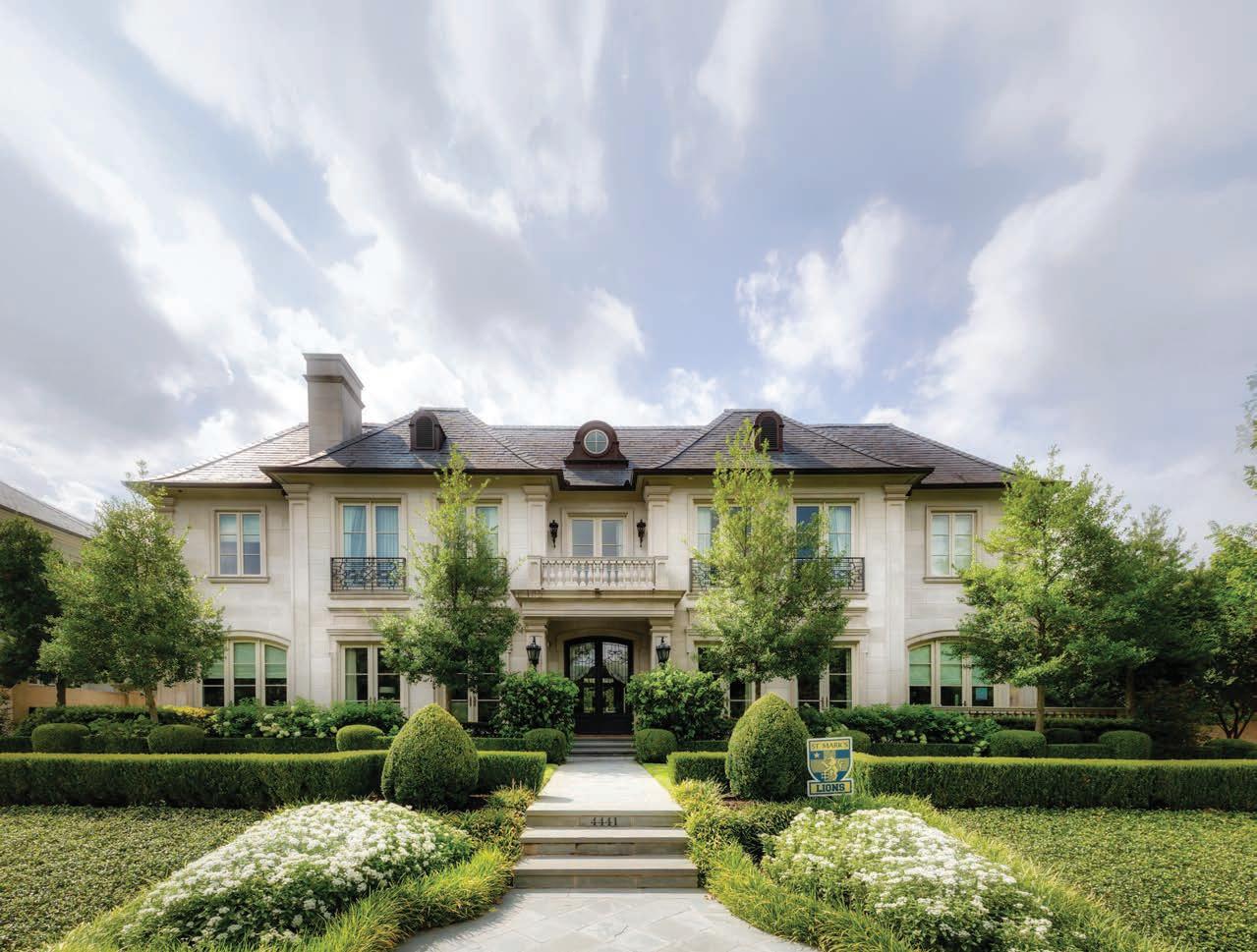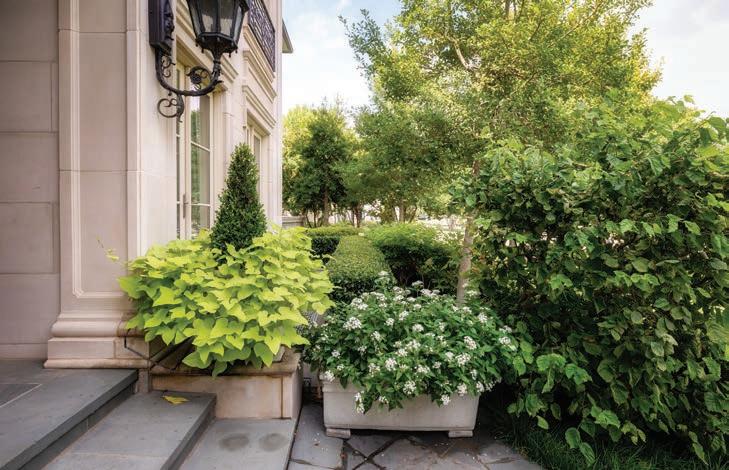
6 minute read
Defeating Dallas-Sized Weather Splendid Gardens Won’t Allow Climate Extremes to Mess With Texas Landscapes
from Summer 2025 Issue - Outdoor Living
by SYNKD—Landscape design, build and maintain all on the same page
By Elizabeth Hark
When the now historic Texas freeze of 2021 hit, it left a trail of destruction. The snow, sleet, freezing rain and extreme cold that took place from February 11–20 caused permanent damage to landscapes that is still being repaired even today. As owner of Dallas, TX-based Splendid Gardens, Landscape Architect Elizabeth Hark sees it firsthand every week. “We still get phone calls,” she comments. “People are still restoring their landscapes from the freeze. It’s amazing.”
Unfortunately, the residual freeze damage is only part of the challenge facing landscapes in the Dallas area today. Texas, like many locations, is experiencing an increasingly unpredictable climate—swinging from scorching summers to deep freezes, all while battling long stretches of drought with intermittent bouts of severe flooding.
Restoration After Deep Freeze
Recently, Splendid Gardens accepted a restoration project unlike any other—taking on the repair of the stunning Highland Park estate. The grounds had been thriving before the freeze but were nearly wiped out by the extreme temperature dip.
“They had lost everything,” even plants prized for their resilience, Hark recalls. “Gardenias, agave, azaleas, grasses, ligustrums— the list goes on.”
The goal wasn’t simply to bring the landscape back to life—but with the client’s large financial commitment and Splendid Gardens’ reputation on the line—the landscape team had to ensure the design could withstand future climate swings.
To accomplish this, Hark and her team had to rethink traditional Dallas-area plant choices. They would have to adopt a new approach to climate-resilient plant selection.
A Smarter Plant Selection
One of the biggest lessons from the freeze was the need to rethink what plants could truly survive the Texas climate—not just drought, but also floods and recordbreaking freezes.
“We went back in with northern-hardy plants—four different types of hydrangeas, including Limelight, Little Lime, native Oakleaf, and Invincibelle Ruby. Also more boxwoods, dwarf hollies, sunshine ligustrums,” Hark explains. “We switched to Zoysia grass instead of St. Augustine because it performs better in extreme weather.”
Hark also pointed out the surprising resilience of certain plants, like contorted filberts, commonly referred to as Harry Lauder’s walking stick. The deciduous shrub provides winter interest with twisty gray branches and hanging catkins, while its small stature, shade tolerance, and adaptability to less rich soils, allows for placement where other trees and shrubs may not thrive. (Highly susceptible to a fungal canker dubbed eastern filbert blight, some varieties developed at Oregon State University, such as Red Dragon, are highly resistant.) Hark continues, “They did fine through the freeze! I don’t think designers use them enough.”


Testing new plants and understanding what works long-term has now become a key strategy in her firm’s work. As a result, Splendid Gardens has actually eliminated the use of certain plants since the freeze. These include: variegated pittosporum, gardenia, Indian hawthorne, Confederate jasmine, and Kaleidoscope abelia.
What are her new favorites? For Hark’s top 10 go-to plants for climate resilience, see below.
The Importance of Irrigation & Maintenance
Beyond rethinking plant selections, Splendid Gardens realized that storm water management was another key element of landscape longevity in an area of wild weather fluctuations.
Splendid Gardens’ TOP 10 Go-To Plants for Climate Resilience
Limelight Hydrangea
Distylium
Snowball Viburnum Globe Boxwood
Sunshine Ligustrum
Weeping Redbud

Baby Gem Boxwood
Bridal Wreath Spirea
Sweetspire
Indigofera
Peony
Cherry Blast Loropetalum
The firm now incorporates innovative smart irrigation solutions to help manage water use efficiently. “We tell clients, if you’re going to invest in a highend landscape, you have to have an irrigation plan that can adjust to droughts and heavy rain,” Hark comments. She actually won’t complete a large landscape project like Highland Park unless the client agrees to this point. She sees it as that important.
She also emphasized the importance of proper irrigation when reintroducing plants to damaged properties. “It’s not just about replanting,” she says. “It’s about ensuring the plants will establish properly and not suffer through the next weather crisis.”
Hark acknowledges that restoring a property at this level is a major investment for the client. “We installed in phases—the summer of ‘22 for phase one, the summer of ‘23 for phase two, and some final touch-ups in 2024,” she says, adding, “But the key to its success? Maintenance.”
Splendid Gardens doesn’t just install and walk away. “We put an extra guy in a truck to hand-water if needed,” comments Hark. “We fertilize weekly. Our lead maintenance employee, Tomas, inspects every single plant. He makes sure nothing is drying out, nothing is failing. That’s why this property already looks like it’s been established for 15 years.”
Facing the Storms Ahead
For Hark, this project brings to light a critical conversation for the industry: “Our plant palette here in Texas is getting smaller and more restrictive because of climate challenges. We need more adaptable plants. We need to talk about how to prepare for extreme weather and educate clients on risks.”
And it’s not just Texas. “The issues we face with drought and deep freezes are similar to what the West deals with in fires and mudslides, “ asserts Hark. As a result, she feels communication and collaboration among those in landscape design, build, and maintenance are key.
Hark says the Highland Park project has been a lesson in resilience—not just for this landscape but for the green industry. “We can’t keep planting the same things and expecting different results,” Hark states. “If we don’t adapt, we’re going to keep losing landscapes.”
She adds, “As landscape stewards, we have to plan for these events better—or at the very least, prepare our clients for them.”
Clearly, plant nurseries are also part of this discussion. The Texas freeze wasn’t just hard on landscapes—it was hard on the nursery industry, too. Supply chain disruptions have made sourcing high-quality plants more challenging. “A 30-gallon holly isn’t what it used to be,” Hark says. “Everything is smaller. Growers can’t keep up and we’ve had to adjust our expectations.”
Hark remains loyal to her go-to supplier, Southwest Wholesale Nursery. “They’ve been so good to me. They gave me credit my first month in business, and I’ve stuck with them ever since,” she says. (For more on procurement, see “Beyond The Buy” in the Spring 2025 edition of SYNKD.)
Splendid Gardens is also doing their part by exploring plant trials. The company is working with breeders to test more resilient varieties. “If there’s a way to help develop better, hardier plants for the future, we want to be part of that,” says Hark.
For now, she and her team will continue their sustainable landscape design, forward-thinking strategies, and hands-on approach to ensure every project thrives despite the challenges. Hark concludes, “The right client will appreciate the work we do because they know it’s built to last. That’s the key—to educate, adapt, and always think ahead.” n
All photos courtesy of Splendid Gardens
About The Author
Elizabeth Hark Owner of Splendid Gardens
Dallas, TX elizabeth@splendidgardens.net www.splendidgardens.net










